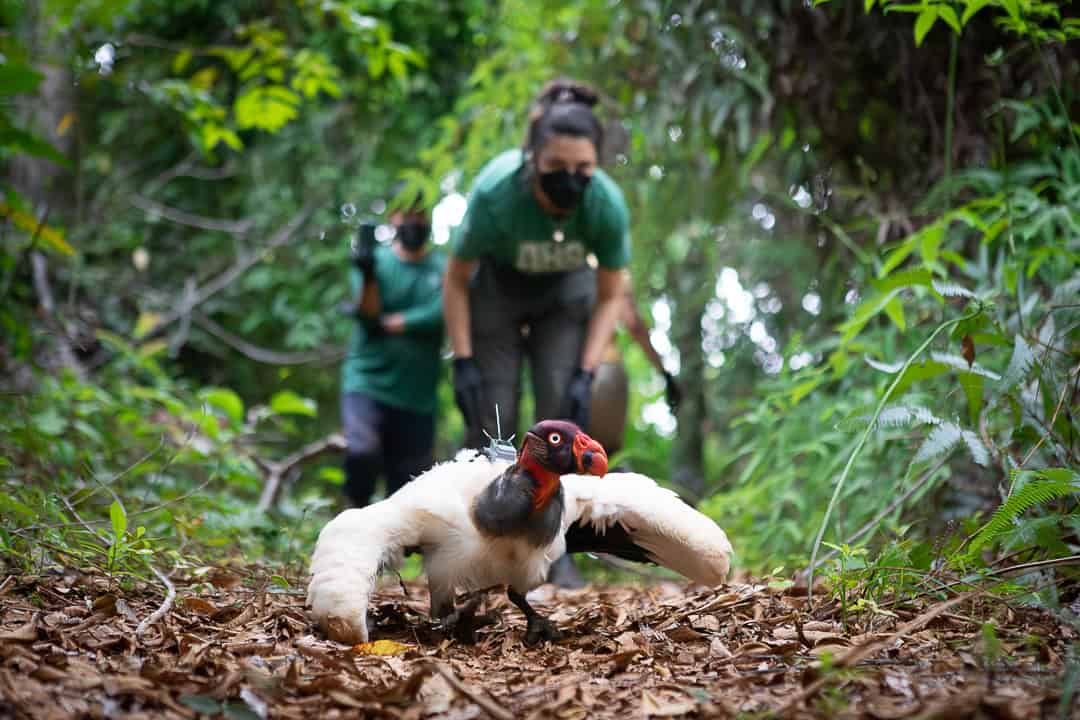The number of camera traps I have in the field at any one moment varies with the number of projects I have. Right now, I have about 40 cameras stuck to trees around the country busily recording whichever creature happens to walk, slither, or fly by. Though I record each camera location with GPS coordinates, I don’t need a little machine to tell me where they are. I can run through each project in my head and picture exactly where every camera is placed.
Let me transport you to one of my favorite current camera locations on a farm called Finca Bella Vida in the area of Pérez Zeledón. This camera sits on an enormous log that was once a huge tree growing out of the bank of a brisk-flowing stream that cuts through the mountainous forest.
At some point the huge tree fell over and tipped across the stream where it laid against a steep hillside at a forty-five-degree angle, at which point it became the best way for wildlife to travel down from the hill and across the stream. The camera is placed about ten meters up the log pointing down towards the water.
About two weeks ago, I put an SD card and some fresh batteries in my pocket and scooted myself up the log to prepare the camera to sit there for another two months, while also reviewing what I had recorded over the last two months. I sat on the log looking at the little LCD screen on the camera, flipping through the hundred or so videos. About ten videos in my heart jumped. A king vulture!
I had only recorded one of these huge, colorful birds once before in Guanacaste. In this new set of recordings, the king vulture landed in front of the camera, sat there posing perfectly for a minute or two, then flew off. I couldn’t wait to get the videos onto my computer to get a better look.
Once I got home to my sweaty little office, I sat watching the videos over and over again, reveling in their vulture-y glory. On probably the tenth round of viewing the videos, I noticed what appeared to be a stray feather or stick poking straight out from between the bird’s wings. Upon further inspection, I realized that the stick or stray feather was actually an antenna. I immediately thought, ‘Osa Conservation!’
Osa Conservation is a nonprofit organization that works to conserve the biodiversity of Southern Costa Rica via a large number of interesting, science-based programs. One of the programs that I had previously read about was one which tracks the movement of three species of vultures, including king vultures, in an attempt to better understand how they use the landscape and guide conservation efforts. It appears the star of my videos was one of Osa Conservation’s vultures.
To confirm my suspicions and in an effort to learn more about the program, I reached out to Osa Conservation’s Director of Wildlife Programs, Dr. Chris Beirne. Chris responded with all sorts of wonderful information. It turns out, my vulture was one of 83 individuals being tracked throughout Costa Rica, Peru, and Ecuador. Also, it’s not just some vulture; it has a name, Charizard.
They had been tracking him or her (you can’t identify the sex without using molecular techniques) for 489 days. In that amount of time, it had traveled from Panama all the way up the coast to San Ramon which makes its home range approximately 3,000 square kilometers! He was even able to tell me that my videos were recorded during a brief stop on a 15-kilometerflight that day.
To track vultures like Charizard, Chris and his team fit a small backpack onto their backs complete with a little antenna like the one that I spotted in my camera trap video. The backpacks are a custom fit for each vulture, weighing a mere 2.5% of the bird’s body mass. They’re designed to have little-to-no interference with the bird’s natural behavior.
The study is ongoing, but the data collected so far have already led to novel scientific discoveries. Just last month, the team at Osa Conservation published a research paper on how vultures interact with each other, an interaction that has never before been researched or published.
I connected with this research study on accident, but you can participate on purpose. If you come across vultures, or any other form of biodiversity, you can log your sightings on iNaturalist, the Osa Biodiversity Survey, and the AmistOsaBiodiversity Survey. Via these apps, your observations become available to scientists internationally and could lead to all sorts of interesting discoveries.
While watching the wildlife videos recorded with my camera traps, I often wonder about each animal’s individual story. Where has that animal been? Has any human ever seen it before? 99.9% of the time these questions go unanswered, but not in the case of this vulture. I know exactly where it’s been. I know that Dr. Chris Beirne and his team have seen it before. Icing on the cake, I even know its name is Charizard!
Take a look at the video below and see my camera trap videos of Charizard as well as a few fantastic photos taken by the researchers during their interactions with these amazing birds.
About the Author
Vincent Losasso, founder of Guanacaste Wildlife Monitoring, is a biologist who works with camera traps throughout Costa Rica. Learn more about his projects on facebook or instagram. You can also email him at: vincent@guanacastewildlifemonitoring.com






